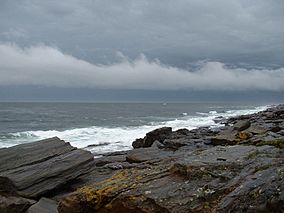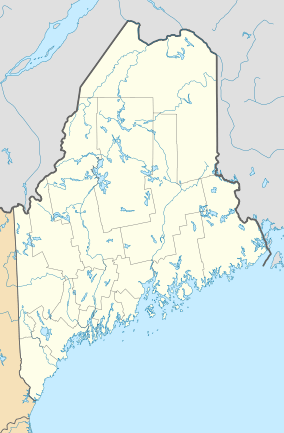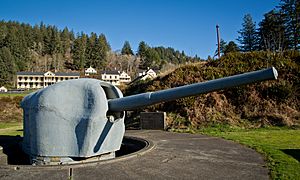Two Lights State Park facts for kids
Quick facts for kids Two Lights State Park |
|
|---|---|
 |
|
| Location | Cape Elizabeth, Cumberland, Maine, United States |
| Area | 41 acres (17 ha) |
| Elevation | 66 ft (20 m) |
| Established | 1961 |
| Operator | Maine Department of Agriculture, Conservation and Forestry |
| Website | Two Lights State Park |
Two Lights State Park is a cool place to visit in Cape Elizabeth, Maine. It's a public park that covers 41 acres of land right on the coast. From here, you can see amazing views of Casco Bay and the huge Atlantic Ocean.
The park opened in 1961. It got its name from the two lighthouses nearby. Even though the lighthouses aren't inside the park, they are a big part of its history. Besides the rocky coast, the park also has old structures from World War II. These include a military bunker and a tower used to control gunfire. The Maine Department of Agriculture, Conservation and Forestry takes care of the park.
Contents
Park History
Ancient Rocks and Land
The rocky ledges you see at Two Lights State Park are very old. They are made of metamorphic rock. This rock first formed as mud and sand at the bottom of the ocean. That was during the Silurian period, hundreds of millions of years ago! The bedrock under the park is part of something called the Kittery formation. You can find this type of rock in New Hampshire and along the coast of Maine.
Lighthouses Nearby
The two famous lighthouses that the park is named after were built in 1828. You can't see them from inside the park itself. However, you can get a good view from a special turnaround spot on Two Lights Road.
One of these lighthouses is still working today. The other lighthouse stopped being used in 1924. During World War II, it was used as a tower to help control military firing. Now, it's a private home. A famous artist named Edward Hopper painted one of these towers in 1929. His painting, The Lighthouse at Two Lights, was even put on a U.S. postage stamp in 1970!
World War II History
During World War II, the area where the park is now was a military base. It was called the Cape Elizabeth Military Reservation. There was a special battery, or group of guns, built here. It was known as Battery Construction Number (BCN) 201. This battery was designed to hold two large 6-inch guns. These guns would have been placed on big concrete circles you can still see today.
There's a sign on one of the gun positions that shows what the bunker looked like inside. But here's an interesting fact: the battery was never actually used! By the time it was finished, there wasn't much danger from enemy ships. This battery was part of a bigger defense plan for the Harbor Defenses of Portland. The main part of this defense was Battery Steele on Peaks Island.
The Eagle 56 Mystery
Something mysterious happened near the park during the war. On April 23, 1945, a U.S. Navy ship called USS Eagle 56 (PE-56) exploded and sank. This happened just a few miles east of the military base. At first, people thought it was a boiler explosion. But in 2001, the Navy found out the truth. The Eagle 56 was actually hit by a torpedo from a German U-boat called U-853. This German submarine was sunk a few weeks later in a battle off Rhode Island.
Activities and Fun at the Park
Two Lights State Park is a great place for outdoor activities! There are almost two miles of paths to explore. You can walk through peaceful forests or along the rocky coast. The park has benches where you can sit and enjoy the ocean views. There are also restrooms, a playground for younger kids, and picnic tables. It's a perfect spot for a family outing!



